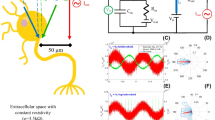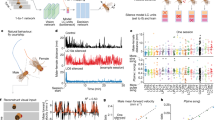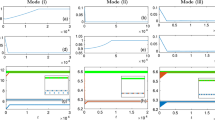Abstract
In this protocol, we present a procedure to analyze and visualize models of neuronal input–output functions that have a quadratic, a linear and a constant term, to determine their overall behavior. The suggested interpretations are close to those given by physiological studies of neurons, making the proposed methods particularly suitable for the analysis of receptive fields resulting from physiological measurements or model simulations.
This is a preview of subscription content, access via your institution
Access options
Subscribe to this journal
Receive 12 print issues and online access
$259.00 per year
only $21.58 per issue
Buy this article
- Purchase on SpringerLink
- Instant access to full article PDF
Prices may be subject to local taxes which are calculated during checkout





Similar content being viewed by others
References
Berkes, P. & Wiskott, L. Applying slow feature analysis to image sequences yields a rich repertoire of complex cell properties. In Artificial Neural Networks-ICANN 2002 Proceedings, Lecture Notes in Computer Science (ed. Dorronsoro, J.R.) 81–86 (Springer, Berlin, 2002).
Berkes, P. & Wiskott, L. Slow feature analysis yields a rich repertoire of complex cell properties. J. Vis. 5, 579–602 (2005).
Marmarelis, P. & Marmarelis, V. Analysis of physiological systems: the white-noise approach (Plenum Press, New York, 1978).
de Ruyter van Steveninck, R. & Bialek, W. Real-time performance of a movement-sensitive neuron in the blowfly visual system: coding and information transfer in short spike sequences. Proc. R. Soc. Lond. B Biol. Sci. 234, 379–414 (1988).
Lewis, E.R., Henry, K.R. & Yamada, W.M. Tuning and timing in the gerbil ear: Wiener-kernel analysis. Hear. Res. 174, 206–221 (2002).
Touryan, J., Lau, B. & Dan, Y. Isolation of relevant visual features from random stimuli for cortical complex cells. J. Neurosci. 22, 10811–10818 (2002).
Rust, N.C., Schwartz, O., Movshon, J.A. & Simoncelli, E.P. Spike-triggered characterization of excitatory and suppressive stimulus dimensions in monkey V1. Neurocomp. 58–60, 793–799 (2004).
Simoncelli, E.P., Paninski, L., Pillow, J.W. & Schwartz, O. Characterization of neural responses with stochastic stimuli. In The Cognitive Neurosciences 3rd edn. (ed. Gazzaniga, M.S.) 327–338 (MIT Press, Cambridge, Massachusetts, 2004).
Rust, N.C., Schwartz, O., Movshon, J.A. & Simoncelli, E.P. Spatiotemporal elements of macaque V1 receptive fields. Neuron 46, 945–956 (2005).
Touryan, J., Felsen, G. & Dan, Y. Spatial structure of complex cell receptive fields measured with natural images. Neuron 45, 781–791 (2005).
Rapela, J., Mendel, J.M. & Grzywacz, N.M. Estimating nonlinear receptive fields from natural images. J. Vis. 4, 441–474 (2006).
Schwartz, O., Pillow, J.W., Rust, N.C. & Simoncelli, E.P. Spike-triggered neural characterization. J. Vis. 6, 484–507 (2006).
Franz, M.O. & Schölkopf, B. A unifying view of Wiener and Volterra theory and polynomial kernel regression. Neural Comput. 18, 3097–3118 (2006).
Hashimoto, W. Quadratic forms in natural images. Netw. Comput. Neural Syst. 14, 765–788 (2003).
Bartsch, H. & Obermayer, K. Second-order statistics of natural images. Neurocomp. 52–54, 467–472 (2003).
Hyvärinen, A. & Hoyer, P. Emergence of phase- and shift-invariant features by decomposition of natural images into independent feature subspaces. Neural Comput. 12, 1705–1720 (2000).
Hyvärinen, A. & Hoyer, P. A two-layer sparse coding model learns simple and complex cell receptive fields and topography from natural images. Vision Res. 41, 2413–2423 (2001).
Körding, K.P., Kayser, C., Einhäuser, W. & König, P. How are complex cell properties adapted to the statistics of natural stimuli? J. Neurophysiol. 91, 206–212 (2004).
Adelson, E.H. & Bergen, J.R. Spatiotemporal energy models for the perception of motion. J. Opt. Soc. Am. A 2, 284–299 (1985).
Berkes, P. & Wiskott, L. On the analysis and interpretation of inhomogeneous quadratic forms as receptive fields. Neural Comput. 18, 1868–1895 (2006).
Wiskott, L. & Sejnowski, T.J. Slow feature analysis: unsupervised learning of invariances. Neural Comput. 14, 715–770 (2002).
Jones, J.P. & Palmer, L.A. An evaluation of the two-dimensional Gabor filter model of simple receptive fields in cat striate cortex. J. Neurophysiol. 58, 1233–1257 (1987).
Acknowledgements
The figures have been reproduced with permission from ref. 20. This work has been supported by a grant to L.W. from the Volkswagen Foundation and by the Gatsby Charitable Foundation.
Author information
Authors and Affiliations
Corresponding author
Ethics declarations
Competing interests
The authors declare no competing financial interests.
Rights and permissions
About this article
Cite this article
Berkes, P., Wiskott, L. Analysis and interpretation of quadratic models of receptive fields. Nat Protoc 2, 400–407 (2007). https://doi.org/10.1038/nprot.2007.27
Published:
Issue date:
DOI: https://doi.org/10.1038/nprot.2007.27
This article is cited by
-
On solving trust-region and other regularised subproblems in optimization
Mathematical Programming Computation (2010)



